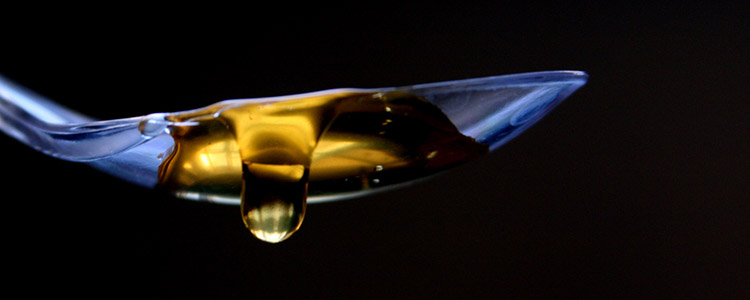Slip-Sliding Away

Image credits: Quinn Dombrowski via Flickr
(Inside Science) -- Research teams at Harvard University and MIT have independently developed methods of making super-slippery surfaces by creating stable mixtures of liquids and solids. Both teams have founded companies to exploit applications of their patented technology.
The developments promise consumer applications such as toothpaste tubes that release the last portions of their contents without the need to roll them up and bottles that deliver ketchup as soon as they are tilted, eliminating the need to squeeze or shake them.
On a larger scale, the technology, known as liquid-impregnated surfaces, could provide surfaces that prevent aircraft wings from icing up in cold weather and that stop underwater marine organisms from fouling ships.
For each team, the technology involves a liquid surface that offers minimal resistance to anything moving past it. That surface is secured to a solid surface lining a vessel by chemical and physical reactions.
"We create surfaces designed to hold liquid in place so that environmental forces cannot squeeze it out," said Joanna Aizenberg, a professor of materials science at Harvard’s Wyss Institute whose team developed the approach and who heads the scientific advisory board of newly formed Cambridge, Massachusetts company SLIPS Technologies.
Dave Smith created a different slippery technology as a graduate student at MIT and is now CEO of LiquiGlide, also based in Cambridge.
In each case the result is a very thin but stable liquid surface over which material can slide without any significant resistance.
"It’s like having a thin sponge on a surface that’s filled with a liquid, giving you a permanently wet surface," Smith added.
Equally important, both approaches to super-slippery surfaces are customizable, in order to best control materials with differing amounts of stickiness.
"Both companies are exploiting the same principle of slippery liquid-impregnated surfaces," said Chiara Neto, an expert on surface chemistry at the University of Sydney in Australia. "I find the science brilliant."
The principle plays out every day at breakfast time.
"Think about putting oil and then an egg in a frying pan," Smith said. "The egg flies around the pan because of a layer of the liquid lubricant."
The slippery effect of the oil used for fried eggs doesn’t last long. But the Harvard and MIT teams have found a method of making its lubricating effect permanent.
"We trap the liquid in place," Smith said.
"Overall you create a liquid on top of a solid – a nice slippery liquid interface that protects your solid," Aizenberg said. "We’re really nucleating a new and original type of materials science … It’s a system that shows very different properties from the liquid itself and the solid itself."
The creation of the new surface materials relies on a physical property called capillarity.
This is the ability of a liquid to flow in narrow spaces uninfluenced by forces such as gravity. It results from a combination of the physical process of surface tension, which prevents liquids escaping from ultra-thin containers, and chemical forces between molecules in the liquid and the solid surrounding it.
Aizenberg gained the inspiration for her research from the natural world, which has plenty of examples of slippery surfaces. Fish scales, for example, are always coated with a lubricant that gives them significant drag reduction. Our guts have porous walls that are fully coated with mucus, a lubricant that screens them from food. And our eyeballs are always coated with a layer of tears.
"We looked for a biological system where the material solves what we want to solve," she said.
The team found that in the surface of the carnivorous pitcher plant.
"Ants can move around it fine on a dry day," Aizenberg noted. "But when it’s wet, the plant locks in water; a layer of water coats the underlying solid causing the ants to hydroplane. The moment the ants step on the rim of the plant on a wet day, they just fly down the hill [into the plant] as if they’re on ice."
The SLIPS company’s idea, Aizenberg continued, "is reformulating that strategy exactly and then improving on it." For example, it can substitute oil or other liquids for water, which can evaporate.
Stabilizing the lubricating layer of liquid involves counterintuitive thinking.
"We use roughness to develop a roughness-free surface," Aizenberg said. "I make my surface roughened to create channels of porosity that pull the liquid down by capillary action. That immobilizes the liquid."
Smith’s version of the approach originated with an issue presented by his MIT supervisor, Kripa Varanasi.
"I was thinking about honey and how hard it is to scrape honey out of the bottom of the jar," Varanasi recalled.
Smith originally wanted to prevent clogs in oil pipelines and to remove ice from airplane wings. But he developed a model of how to create liquid-impregnated slippery surfaces for a wide variety of uses.
"We can devise a coating that can work with mayonnaise but not necessarily with a pipeline or a lotion," Smith said. "We custom design coatings for different applications. We have thousands of combinations we can use."
Smith’s firm, LiquiGlide, expects to offer its first products next year. Possibilities include coatings for the large containers used to transport frozen egg yolks, as well as ice cream molds that are notoriously difficult to clean. The following year, Smith predicts that his firm will offer coatings for food items on supermarket shelves.
SLIPS Technologies, which recently announced an agreement with chemical company BASF to coat polyurethanes, takes a longer-term view.
"I have at least 25 people working on the topic, looking at how to apply it on various materials, in high and low temperatures, and marine fouling," Aizenberg noted.

